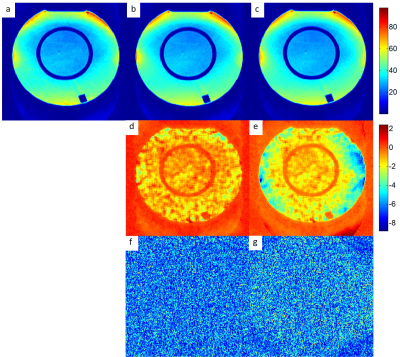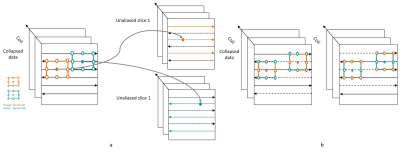Wei Liu1, Simon Bauer2, and Stephan Kannengiesser2
1Siemens Shenzhen Magnetic Resonance Ltd, Shenzhen, China, 2Siemens Healthcare GmbH, Erlangen, Germany
1Siemens Shenzhen Magnetic Resonance Ltd, Shenzhen, China, 2Siemens Healthcare GmbH, Erlangen, Germany
The proposed g-factor calculation method allows a practical,
accurate quantification of the noise map in SG-DK reconstructions.

Figure 2. Quantitative SNR maps derived from (a) the pseudo multiple-replica method (Mean SNR: 19.34), (b) directly from the proposed method (Mean SNR:
19.75), and (c) neglecting kernel phase correction (Mean SNR: 20.13). The
difference map (d) is from (a) and (b), (e) is from (a) and (c). The
deviation of the reconstructed synthetic noise and the calculated noise map is
shown in (f) and (g), with similar RMS (~1.02). Both (d) and (f) show that the
noise map with phase correction is more consistent with the reference method.

Figure 1. (a)
schematic of the SG-DK method to obtain the k-space data for a unaliased
slice. Two kernel sets are calculated for odd and even lines in each unaliased
slice respectively; (b) schematic of the kernel rearranging. By exchanging some
kernel values, the new kernel sets can be applied on disjunct sets of k-space
in collapsed data respectively. The final unaliased slice is then obtained by
adding two reconstructed data from these two kernels. It notes
that the full k-space of collapsed data has been divided into two sets with
zero-padded lines (indicated with dot lines).
